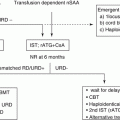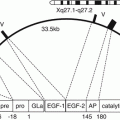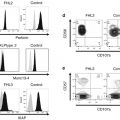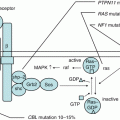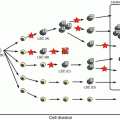Fig. 8.1
Population-based epidemiological study of 7774 patients with ITP in a Japanese population [9]. A population of 7774 patients with ITP were analyzed retrospectively using the database registry of the Ministry of Health, Labour, and Welfare of Japan from 2004 to 2007
Table 8.1 shows that major bleeding manifestations of children with ITP were purpura (92.6%) and nasal bleeding (29.7%), the frequency of which was significantly higher than that in adults with ITP. It is particularly interesting that intracranial hemorrhage, a severe complication, is extremely rare in children (0.1%), but less in adults (0.7%), suggesting an involvement of age-related physiological changes [10]. The clinical features at diagnosis, such as >10 years of age, >2 × 104/μL of platelet counts, and the absence of precedent infection or vaccination, are correlated significantly with the risk of transition to chronic ITP [11].
Table 8.1
Comparative study of hemorrhagic manifestations between pediatric and adult patients with ITP [9]
Hemorrhagic manifestations | Pediatric patients (%) | Adult patients (%) | p Value |
|---|---|---|---|
Purpura | 860 (92.6) | 4300 (62.8) | p < 0.001 |
Gingival bleeding | 175 (18.8) | 1365 (19.9) | ns |
Nasal bleeding | 276 (29.7) | 687 (10.0) | p < 0.001 |
Hematuria | 54 (5.8) | 453 (6.6) | ns |
Melena | 43 (4.6) | 259 (3.8) | ns |
Hypermenorrhea | 11 (1.2) | 264 (3.9) | p < 0.001 |
Intracranial hemorrhage | 1 (0.1) | 45 (0.7) | p < 0.05 |
Other bleedings | 54 (5.8) | 214 (3.1) | p < 0.001 |
Total | 929 | 6845 |
8.3 Immune-Mediated Mechanism(s) Causing Thrombocytopenia
Although clinical findings, such as frequent preceding infectious events and therapeutic effect of splenectomy, suggest the involvement of immunological mechanisms in the onset of ITP, it is also known that ITP children often lack direct evidence of immune-mediated mechanisms [1]. Recently, “a cryptic epitope model” in cellular and molecular pathogenesis has been presented for adult ITP, where autoreactive CD4+ T cells that can recognize the cryptic peptides derived from platelets might promote peripheral B-cell production of antiplatelet GPIIb/IIa antibodies [12, 13].
Compared to ITP in adult, childhood ITP has clinical features that are often characterized by remission after a short duration and precedent events such as infection or vaccination, suggesting the background factors of physiologically and developmentally immature immunological regulation systems [14].
8.4 International Standardization of Terminology, Definitions, and Outcome Criteria
The Japanese Society of Pediatric Hematology proposed conventional guidelines of diagnosis, treatment, and management for childhood ITP [17]. The guideline, in which ITP stands for idiopathic thrombocytopenic purpura of unknown causes, had been used for many years and prevailed in Japan. Recently, international standardization of terminology, definitions, and outcome criteria has been proposed and acknowledged around the country [3]. This standardization proposes ITP as “immune thrombocytopenia,” which is not a single disease but comprising various diseases with thrombocytopenia commonly caused by immunological mechanisms.
Firstly, as shown in Table 8.2, the international standardization classifies ITP into two categories, primary and secondary ITP, in which the primary ITP corresponds to conventional ITP of unknown causes. The secondary ITP includes disorders showing thrombocytopenia, which are strongly associated with immunological pathogenesis, such as underlying immune-mediated diseases or drug-induced reactions. Consequently, several diseases that have been exclusive from conventional ITP can become inclusive of the secondary ITP, leading to increased importance of some inherited disorders with thrombocytopenia as diseases in differential diagnosis of ITP.
A. Definitions of disease |
Abbreviation of ITP: immune thrombocytopenia |
Primary ITP |
• Isolated thrombocytopenia (peripheral blood platelet count <10 × 104/μL) in the absence of other causes or disorders that may be associated with thrombocytopenia |
• The diagnosis of primary ITP remains one of exclusion; no robust clinical or laboratory parameters are currently available to establish its diagnosis with accuracy |
• The main clinical problem of primary ITP is an increased risk of bleeding, although bleeding symptoms may not always be present |
Secondary ITP |
• All forms of immune-mediated thrombocytopenia except primary ITP |
• Secondary forms of thrombocytopenia that are due to an underlying disease or to drug exposure. The name of the associated disease should follow the designation, for example, secondary ITP (SLE associated) or (HIV associated) |
B. Phase of the disease |
Newly diagnosed ITP: within 3 months from diagnosis |
Persistent ITP: between 3 and 12 months from diagnosis, includes patients not reaching spontaneous remission or not maintaining complete response off therapy |
Chronic ITP: lasting for more than 12 months |
Severe ITP: presence of bleeding symptoms at presentation sufficient to mandate treatment or occurrence of new bleeding symptoms requiring additional therapeutic intervention with a different platelet-enhancing agent or an increased dose |
C. Criteria for assessing response to ITP treatment |
CR(complete response): platelet count ≥10 × 104/μL and absence of bleeding |
R(response): platelet count ≥3 × 104/μL and at least twofold increase the baseline platelet count and absence of bleeding |
NR(no response): platelet count <3 × 104/μL or less than twofold increase of baseline count or bleeding |
Loss of CR or R: platelet count below 10 × 104/μL or bleeding (from CR) or below 3 × 104/μL or less than twofold increase of baseline platelet count or bleeding (from R) |
D. Refractory ITP (all need to be met) |
• Failure to achieve at least R or loss of R after splenectomy |
• Need of treatment(s) to minimize the risk of clinically significant bleeding. Need of on demand or adjunctive therapy alone does not qualify the patient as refractory |
• Primary ITP confirmed by excluding other supervened causes of thrombocytopenia |
Secondly, the international standardization has introduced the concept of “phases of the disease (newly diagnosed, persistent, and chronic ITP)” in substitution of types of the disease (acute and chronic ITP) to avoid an uncertain type of disease at onset, for which confirmation by definition requires evaluation for a certain period. Moreover, it advises 12 months of observation until diagnosis of the chronic ITP to avoid excessive treatment for numerous patients who can have remission of thrombocytopenia within 12 months after onset. In addition, severe ITP is defined as the state with the presence of bleeding symptoms sufficient to mandate treatment or occurrence of new bleeding symptoms requiring additional therapeutic intervention.
Thirdly, the international standardization has proposed outcome criteria that define the conditions to evaluate therapeutic effects: CR, complete response; R, response; NR, no response; and refractory state of ITP. Although these criteria are apparently rather broad and simple, the consensus criteria for therapeutic evaluation and disease states are indispensable for comparative and cooperative investigations among different study groups.
8.5 Treatments [17, 18]
8.5.1 Conventional Treatments
Steroid and intravenous immunoglobulin (IVIG) are two major conventional drugs in the first-line therapy for children with ITP. Children with newly diagnosed ITP presenting with bleeding symptom and <2 × 104/μL of platelet counts are treated with steroids (2 mg/kg) or IVIG (1–2 g/kg), although a wait-and-see approach might be used for patients with minimal bleeding. Approximately, 70–80% of children with newly diagnosed ITP are likely to have complete response within 6–12 months after diagnosis. For children with chronic, but not severe ITP, close observation without treatment is a possible consideration in cases of minimal bleeding, even at <2 × 104/μL of platelet count. However, patients with severe ITP in chronic phase or refractory ITP need treatment including second-line therapy.
Conventional second-line treatment for severe or refractory ITP includes splenectomy and immunosuppressive agents such as cyclophosphamide, cyclosporin A, and dapsone (diaphenylsulfone). Although splenectomy is a reliable second-line therapy, its application to children has become less frequent since the introduction of new agents such as rituximab and thrombopoietin receptor (TPO-R) agonists in clinical areas. A review of these two therapeutic agents is presented below.
8.5.2 Rituximab
Rituximab is a chimeric monoclonal antibody that targets CD20 antigen on the surface of B cells. It is applied initially to B-cell lymphoma and, then, expanded to autoimmune diseases. In contrast to the wide use of rituximab in adult patients, few data are available for the long-term efficacy of rituximab for childhood ITP [19, 20]. Recently, a retrospective study in Japan of the long-term effects of rituximab for 22 children with refractory ITP [21] reported that the initial CR rate as high as 41% (9/22) decreased gradually to a 14% (3/22) relapse-free CR rate at 5 years after the first rituximab therapy. Consequently, although sustained effects of rituximab on children with refractory ITP might occur only with low probability, repeated rituximab administration might be a promising therapy because patients who have received multiple courses of rituximab after relapse responded each time without adverse effects and obtained remission.
8.5.3 TPO-R Agonists
Eltrombopag and romiplostim, TPO-R agonists in the second generation, are low-molecular compounds that stimulate signaling through TPO-R without inducing a neutralizing antibody against TPO. TPO-R agonists were effective and safe in approximately 80% of adult patients with refractory ITP [22, 23]. These agents have two specific properties: a loss of effect after withdrawal and an increased risk of myelofibrosis. Although TPO-R agonists are effective also for children with refractory ITP, a retrospective study of children receiving TPO-R agonists for up to 53 months revealed that one of 24 patients developed myelofibrosis in grade 2 [24]. The guideline of the American Society of Hematology continues to advise a cautious attitude related to TPO-R agonists for children with ITP [25].
8.6 Inherited Thrombocytopenia
Recent advances of genetic investigation of inherited thrombocytopenias (ITs) have greatly enhanced the understanding of ITs at the molecular and genetic levels, leading to identification of new responsible genes and a better characterization of ITs [4]. To date, ITs constitute at least 22 disorders caused by mutations of 25 genes with different degrees of complexity in phenotypes and variation in prognosis (Table 8.3) [5]. Conventionally, ITs are classified using characteristic small-, normal-, or large-sized platelets, respectively. The platelet size is denoted either by the mean platelet diameter (upper limit of normal range, 4 μm) or by the mean platelet volume (MPV) (normal range, 7.2–11.1 fL). Recently, with greater emphasis on symptoms, Pecci has categorized ITs into two groups according to symptoms and organs involved by ITs: syndromic and non-syndromic forms [5].
Table 8.3
Main clinical features of inherited thrombocytopenia
Disease (abbreviation, OMIM entry) | Inheritance | Gene (locus) | Platetlet size | Bleedinga | Main clinical feature | Reference |
|---|---|---|---|---|---|---|
Syndromic forms | ||||||
MYH9-related disease (MYH9-RD, na) | AD | MYH9 (22q12) | Large | A to Mi | Sensorineural deafness, nephropathy, cataract, and/or elevated liver enzymes. Giant platelets. Döhle-like inclusions in granulocytes. Also non-syndromicb | |
Wiskott–Aldrich syndrome (WAS, 301000) | XL | WAS (Xp11) | Small | S | Severe immunodeficiency leading to early death. Eczema | |
Increased risk of malignancies and autoimmunity | ||||||
Reduced platelet sizw | ||||||
X-linked thrombocytopenia (XLT, 313900) | XL | WAS (Xp11) | Small | A to Mo | Mild immunodeficiency. Mild transient eczema | |
Increased risk of malignancies and autoimmunity | ||||||
Also non-syndromicb | ||||||
Paris–Trousseau thrombocytopenia (TCPT, 188025) | AD | Deletions in 11q23 | Normal | Mo to S | Physical growth delay, mental retardation, facial and skull dysmorphisms, malformations of the cardiovascular system, CNS, gastrointestinal apparatus, kidney, and/or urinary tract; other malformations | |
Jacobsen syndrome (JBS, 147791) | ||||||
Thrombocytopenia-absent radius syndrome (TAR, 274000) | AR | RBM8A (1q21) | Normal | S | Bilateral radial aplasia +/− other upper and lower limb bone abnormalities. Kidney, cardiac, and/or CNS malformations. Reduced/absent megakaryocytes in BM | |
Platelet count tends to raise over time | ||||||
Thrombocytopenia associated with sitosterolaemia (STSL, 210250) | AR | ABCG5, ABCG8 (2p21) | Large | A to Mi | Tendon and tuberous xanthomas. Premature atherosclerosis. Hemolytic anemia with stomatocytosis | |
Large platelets. Also non-syndromicb | ||||||
Radioulnar synostosis with amegakaryocytic thrombocytopenia (RUSAT, 605432) | AD | HOXA11 (7p15) | Normal | S | Bilateral radio-ulnar synostosis +/− other malformations | |
EVI1 (3q26) | Reduced/absent megakaryocytes in BM. Possible evolution to bone marrow aplasia | |||||
GATA1-related disease: X-linked thrombocytopenia with thalassemia (XLTT, 314050), X-linked thrombocytopenia with dyserythropoietic anemia (XLTDA, 300367) | XL | GATA1 (Xp11) | Mi to S | Hemolytic anemia with laboratory abnormalities resembling beta-thalassemia, splenomegaly, or dyserythropoietic anemia | [41] | |
Congenital erythropoietic porphyria | ||||||
FLNA-related thrombocytopenia (FLNA-RT, na) | XL | FLNA (Xq28) | Large | Mi to Mo | Periventricular nodular heterotopia (OMIM 300049) | [42] |
Large platelets. Also non-syndromicb | ||||||
Non-syndromic forms | ||||||
Bernard–Soulier syndrome (BSS, 231200/153670) | GP1BA (17p13) | Large | ||||
Biallelic | AR | GPIBB (22q11) | S | Giant platelets | ||
Monoallelic | AD | GP9 (3q21) | A to Mi | Large platelets | ||
Congenital amegakaryocytic thrombocytopenia (CAMT, 604498) | AR | MPL (1p34.2) | Normal | S | Reduced/absent megakaryocytes in BM. Evolution to fatal bonemarrow aplasia in infancy in all patients
Stay updated, free articles. Join our Telegram channel
Full access? Get Clinical Tree
 Get Clinical Tree app for offline access
Get Clinical Tree app for offline access

| |
